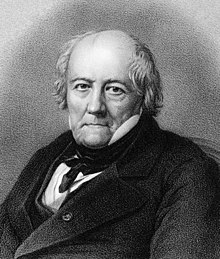Jean-Baptiste Biot
| Jean-Baptiste Biot | |
|---|---|

Jean-Baptiste Biot
|
|
| Born |
21 April 1774 Paris |
| Died | 3 February 1862 (aged 87) Paris |
| Nationality | French |
| Fields | Physics, astronomy and mathematics |
| Alma mater | École Polytechnique |
| Academic advisors | Gaspard Monge |
| Known for | Biot–Savart law |
| Influenced | Louis Pasteur, William Ritchie |
| Notable awards | Rumford Medal (1840) |
| Signature | |
Jean-Baptiste Biot (French: [bjo]; 21 April 1774 – 3 February 1862) was a French physicist, astronomer, and mathematician who established the reality of meteorites, made an early balloon flight, and studied the polarization of light. The mineral biotite was named in his honor.
Jean-Baptiste Biot was born in Paris on 21 April 1774 the son of Joseph Biot, a treasury official.
He was educated at Lyceum Louis-le-Grand and École Polytechnique in 1794. Biot served in the artillery before he was appointed professor of mathematics at Beauvais in 1797. He later went on to become a professor of physics at the Collège de France around 1800, and three years later was elected as a member of the French Academy of Sciences. In 1804 Biot was on board for the first scientific hot-air balloon ride with Gay-Lussac (NNDB 2009, O’Connor and Robertson 1997). They reached a height of 7016 metres (23,000 feet), quite dangerous without supplementary oxygen.
Biot was also a member of the Legion of Honor; he was elected chevalier in 1814 and commander in 1849. In 1815, he was elected a Foreign Member of the Royal Society of London, in 1816 a member of the Royal Swedish Academy of Sciences, and 1822 a Foreign Honorary Member of the American Academy of Arts and Sciences. In addition, Biot received the Rumford Medal in 1840, awarded by the Royal Society in the field of thermal or optical properties of matter. (O’Connor and Robertson 1997). In 1850 Jean-Baptiste Biot published in the Journal des savants a 7-page memoir from his recollections of the period of the late 1790s and early 1800s concerning his encounters with Laplace.
...
Wikipedia
